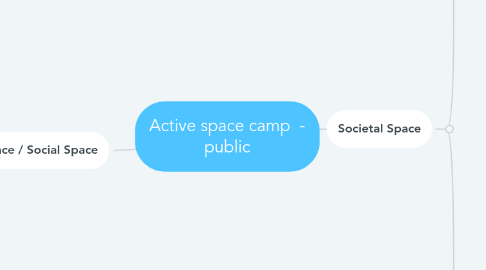
1. Body Space / Social Space
1.1. Map with all spaces of possibilities
1.2. Collages, Maps and gestures
1.2.1. Session 1 - Body space: Search for Spaces of possibilities - Spaces where it feels free to act and an openness for something new to happen. Search for such spaces - chose one and make photo of gesture that expresses that feeling
1.2.2. Session 2 - Social space: Groups are formed and revisit the spaces chosen by the members of the groups. The groups decide for a word that describes that space.
1.2.3. Peaceful encounter
1.2.3.1. Map
1.2.3.2. Gesture
1.2.3.3. Collage
1.2.4. Transition
1.2.4.1. Map
1.2.4.2. Gesture A
1.2.4.3. Gesture B
1.2.4.4. Collage
1.2.5. Timeline
1.2.5.1. Gesture
1.2.5.2. Map
1.2.5.3. Collage
1.2.6. Futurity
1.2.6.1. Map
1.2.6.2. Gesture
1.2.6.3. Collage
1.2.7. Play
1.2.7.1. Gesture
1.2.7.2. Map
1.2.7.3. Collage
1.2.8. Blooming
1.2.8.1. Collage
1.2.8.2. Gesture
1.2.8.3. Map
1.2.9. Sharing
1.2.9.1. Map
1.2.9.2. Gesture
1.2.9.3. Collage
1.2.10. Light
1.2.10.1. Map
1.2.10.2. Collage
1.2.10.3. Gesture
1.2.11. Peephole
1.2.11.1. Map
1.2.11.2. Gesture
1.2.11.3. Collage
1.2.12. Balanced
1.2.12.1. Map
1.2.12.2. Gesture
1.2.12.3. Collage
1.2.13. Mediterranean
1.2.13.1. Collage
1.2.13.2. Gesture
1.2.13.3. Map
1.2.14. No word
1.2.14.1. Gesture
1.2.14.2. Map
1.2.14.3. Collage
1.2.15. Childhoodish
1.2.15.1. Map
1.2.15.2. Gesture
1.2.15.3. Collage
1.3. Session 2 - social space: Agenda
1.3.1. Group A
1.3.1.1. Nutella city - monoculture
1.3.1.2. Quality of encounter
1.3.1.3. Multiculture of content and people
1.3.1.4. Flexibility - fluidity
1.3.1.5. Play
1.3.1.6. Action
1.3.1.7. future
1.3.2. Group B
1.3.2.1. Joy
1.3.2.2. Ecosystem
1.3.2.3. No transaction
1.3.2.4. No toxic masculinity
1.3.2.5. Solidarity
1.3.2.6. Sharing
1.3.2.7. Caring relationships
1.3.3. Feedback from local actors
1.3.3.1. Space of production
1.3.3.2. Number of tourists/hotels
1.3.3.3. Criminality - money laundering
1.3.3.4. Smooth city
2. Societal Space
2.1. Session 3 - Societal space: initial ideas of the groups and internal discussion
2.1.1. Group A
2.1.1.1. Overtourism
2.1.1.2. New way of communication
2.1.1.3. Guerilla activism advertisement
2.1.1.4. Not the right story
2.1.1.5. City advertisement
2.1.2. Group B
2.1.2.1. Layered public spaces
2.1.2.1.1. Rooftop?
2.1.2.2. Trust fund from local businesses - big corps, sex industry, Nutella shops
2.1.2.3. Vacancy research group
2.1.2.4. % of vacant spaces given to social exchange
2.1.2.5. 300 vacant spaces
2.1.2.6. Vacancy visualisation
2.1.2.7. Relational objects in public spaces - open spaces
2.2. Session 3: Societal space - scenarios - how to reach the agendas and public discussion of scenarios
2.2.1. Group A
2.2.1.1. Facts
2.2.1.1.1. Benefits: 64,1 bil UER
2.2.1.1.2. Costs: 64,5 Bill EUR
2.2.1.1.3. 21 Mill tourists 2019
2.2.1.1.4. 1,7 Mill AirBNB
2.2.1.2. Posters
2.2.1.2.1. 1,5 below sea level
2.2.1.2.2. No photos of tourists
2.2.1.2.3. Europes dirtiest capital
2.2.1.2.4. Free alcohol zone
2.2.1.3. Arguments
2.2.1.3.1. Put the data on public posters
2.2.1.3.2. How is the city portrayed?
2.2.1.3.3. Collaborations
2.2.1.3.4. Printing workshops
2.2.1.3.5. Local printers w 139
2.2.1.3.6. Public happenings
2.2.1.3.7. Making data visible using humuor
2.2.1.3.8. different ways of communication
2.2.1.3.9. Public posters campaign
2.2.1.3.10. Possible scenarios
2.2.1.3.11. over tourism
2.2.1.3.12. the neighbourhood is crowded and under pressure
2.2.1.3.13. Different messages/voices
2.2.1.3.14. Party Capital
2.2.1.3.15. Not the full story
2.2.1.3.16. Look into the regulations
2.2.1.3.17. Focus on big capital
2.2.1.3.18. Commentary on public policy - warning signs
2.2.2. Group B
2.2.2.1. Vacancy Research group
2.2.2.1.1. Immediate future scenario
2.2.2.1.2. Not too far Scenario
2.2.2.1.3. Facts
2.2.2.1.4. Wishes
2.2.2.2. Discussion with votes
2.2.2.2.1. (13) Budget?
2.2.2.2.2. (12) Who owns the spaces
2.2.2.2.3. (11) Public database of vacant spaces
2.2.2.2.4. (11) Not starting from scratch - work has been done already
2.2.2.2.5. Visual signage for empty spaces
2.2.2.2.6. Mapping the area
2.2.2.2.7. Secluded high spaces - non exclusive - how?
2.2.2.2.8. Sound in city layers
2.2.2.2.9. Detective work for owners far away
2.2.2.2.10. connections with public services and local policy makers
2.2.2.2.11. donations library
2.2.2.2.12. Get existing overview from Gemeente
2.2.2.2.13. Who is in the room
2.2.2.2.14. Make website where big anonymous owners are uncovered - with name and photo
2.2.2.2.15. Relational objects in public spaces - public spaces
2.2.2.2.16. What do we mean by calm
2.2.2.2.17. Dream out loud
2.2.2.3. Discussion without votes
2.2.2.3.1. Vacancy visualisation - apart from Funda - non profit
2.2.2.3.2. % of vacant space given to social production - exchange
2.2.2.3.3. Gemeente IOS - already existing research
2.2.2.3.4. Who of the W139 will facilitate this group
2.2.2.3.5. Research secluded spaces
2.2.2.3.6. Collaborate more at/within social/art spaces
2.2.2.3.7. Affordable housing for artists and others
2.2.2.3.8. W139 as a vacant space
2.2.2.3.9. Association of onderneemers
2.2.2.3.10. Radical vacancy - create vacancy
2.2.2.3.11. Who wants to take initiative?
2.2.2.3.12. Open space where you dont have to consume
2.2.2.3.13. Start the map
2.2.2.3.14. Is it under Platform BK or W139?
2.2.2.3.15. Close relationship with a legal body (NGO) or
2.2.2.3.16. What do they need?
2.2.2.3.17. Find people
2.2.2.3.18. Research
2.2.2.3.19. Groups don't come together
2.2.2.3.20. Relational public open spaces
